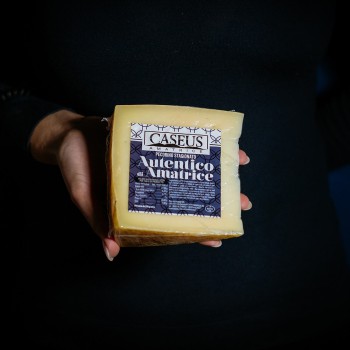


 Accepted payment methods. Secure checkout.
Accepted payment methods. Secure checkout. The Pecorino cheese from Amatrice, not to be confused with the Pecorino Romano cheese, is a supreme delicacy which maintains a unique and indivisible bond with its original territory. It is a sheep milk, full-fat, hard and long-aged kind of cheese. Pecorino cheese from Amatrice is a PAT (Traditional Agro-food Product) product, therefore it is only produced in the province of Rieti and the Amatrice territory. The production methods are very traditional: the aging process goes from 6 months to one year and the wheels, previously stewed and salted in brine, are treated on the surface with oil and vinegar.
Pecorino cheese from Amatrice’s taste truly is special. When the wheel is well aged, its paste is compact and crumbly, straw-colored. Its scent is the unmistakable one of sheep’s milk, but also recalls the vegetal scents of the pastures. The taste is intense, quiter spicy, but not too salty. This is the main difference with Pecorino Romano cheese, which has a stronger sapidity. There are endless ways to eat this delicacy, the 3 most famous ones being: on “pasta all’Amatriciana”, on “pasta alla Gricia” and on “cacio e pepe” pasta.
Caseus Amatrice is a brand by Caseificio Storico di Amatrice from the Petrucci company, which has been producing high quality dairy products for over 50 years. The factory is located within the Gran Sasso and Monti della Laga National Park, in a space surrounded by nature at 1000 m above sea level. This dairy farm uses 100% Italian milk, only from Amatrice and the surrounding areas and it is processed within 24 hours from its collection. Traditional recipes, craftsmanship, skilful seasoning: an absolute guarantee of excellence.
Pecorino cheese from Amatrice holds an indissoluble bond with its original territory. It is part of the TAP (Traditional Agri-food Products) products and it’s exclusively produced in the province of Rieti and the Amatrice territory.
It is a whole sheep’s milk, full-fat, hard, compact, crumbly, straw-coloured kind of cheese. The crust is hard, oily, much darker than the inside.
The wheels are quite small, they go from 2 to 3 kilos. They are stewed and salted in brine, and then treated on the surface with oil and vinegar. The seasoning goes from six months to a year, for a product with an increasingly strong taste and spicyness.
The scent is simply unmistakable. Without taking anything away from Pecorino Romano cheese, mind you, but here you can perfectly perceive all the vegetal scents of the pastures.
Compared to Pecorino Romano cheese, it has a softer and less invasive taste, less savory and slightly spicy. They may get confused – probably because of the recipes they share and are contended for - but let’s be honest, the taste is completely different.
Loud and clear: Amatriciana pasta only demands Pecorino cheese from Amatrice. Of course, if you put a good PDO Pecorino Romano cheese you’ll still have an exceptional dish, but know that, technically, it would be historically inaccurate.
But it’s not over, with Pecorino cheese from Amatrice you can prepare many tasty dishes that are not too intrusive on the palate. How about a nice arugula and almond pesto?
You can also try it on baked pasta, artichoke risotto, in flans or as an additional ingredient for shortcrust pastry. In short, with such a product, you really need very little imagination to create truly memorable dishes.
For both Pecorino Romano cheese and Pecorino cheese from Amatrice, we from Italy Bite had no doubt and have entrusted ourselves to Caseus Amatrice by the Petrucci Brothers from Rieti.
The dairy farm is located within the Gran Sasso and Monti della Laga National Park, in a pristine environment and surrounded by the most lush nature, between the woods and the Tronto river, 1000 meters above sea level.
The milk only comes from the nearby pastures and is processed within 24 hours from milking, for the agingprocess there are Etruscan-Roman tuff caves from the first century B.C.